Sold antiquities
Archive of sold antiquities
All artefacts sold in our gallery are fully documented in our online archive and database. Being a specialist ancient art dealer, preserving also the more recent history of each and every piece sold in our shop is at our heart. That is particularly useful for artefacts that changed owners in the meantime. Information that may have been lost in the process can be easily restored from our archives. Please do not hesitate to contact us if you need further information about ancient items that have been sold in our gallery. We can help you with reconstructing the history of ownership for those items. All information about our customers will be kept confidential, of course.-
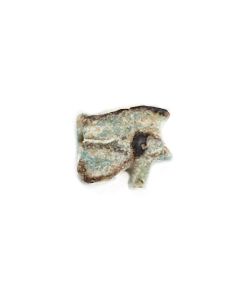 Eye of Horus from the Third Intermediate Period of Egypt
Eye of Horus from the Third Intermediate Period of EgyptSmall amulet in form of the Eye of Horus. Popular type of protective amulet from Ancient Egypt.
Price: on request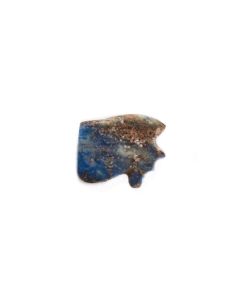 Egyptian Eye of Horus made of lapis lazuli
Egyptian Eye of Horus made of lapis lazuliSmall amulet in form of the Eye of Horus. Popular type of protective amulet from Ancient Egypt.
Price: on request Egyptian Eye of Horus in rectangular frame
Egyptian Eye of Horus in rectangular frameSmall amulet in form of the Eye of Horus. Popular type of protective amulet from Ancient Egypt.
Price: on request Egyptian ushabti for Somtus-tefnacht
Egyptian ushabti for Somtus-tefnachtThe mummiform funerary figurine dates to the Late Period of ancient Egypt, 26th to 31st dynasty. It is remarkable that it probably originates from the burial of two brothers, Somtus-tefnacht and Somtus-tefnacht.
Price: on request Egyptian ushabti for Somtus-tefnacht
Egyptian ushabti for Somtus-tefnachtThe mummiform funerary figurine dates to the Late Period of ancient Egypt, 26th to 31st dynasty. It is remarkable that it probably originates from the burial of two brothers, Somtus-tefnacht and Somtus-tefnacht.
Price: on request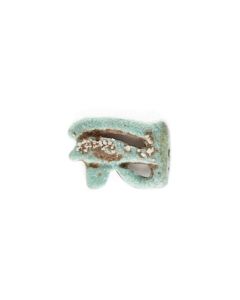 Egyptian Eye of Horus with empty spaces
Egyptian Eye of Horus with empty spacesSmall amulet in form of the Eye of Horus. Popular type of protective amulet from Ancient Egypt.
Price: on request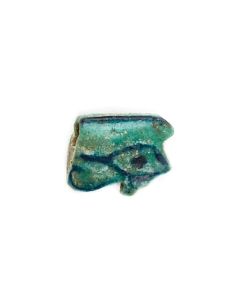 Egyptian Eye of Horus
Egyptian Eye of HorusSmall amulet in form of the Eye of Horus. Popular type of protective amulet from Ancient Egypt.
Price: on request Alexander III the Great Tetradrachm
Alexander III the Great TetradrachmExtremely fine attractive piece with beautiful patina. Coined during the reign of Alexander.
Price: on request Painted Bronze Age cup
Painted Bronze Age cupThe well preserved Bronze Age pottery bears a geometric painted pattern. Acquired in 1977 at Davies Antiques in London, it is claimed to have been found in Syria.
Price: on request Large Attic terracotta figure of a woman
Large Attic terracotta figure of a womanDelicate work of art, very nicely preserved. From the collection of Professor Robert McElderry (1869 – 1949), acquired in Greece in the 1930s
Price: on request Ptolemaic sarcophagus mask
Ptolemaic sarcophagus maskImpressive wood relief of an idealized face. Remains of paint. The mask was part of a sarcophagus lid from Ancient Egypt during ptolemaic rule.
Price: on request Egyptian sarcophagus mask
Egyptian sarcophagus maskImpressive wood relief of an idealized face. Polychrome paint. The mask was part of a sarcophagus lid from the New Kingdom of Ancient Egypt.
Price: on request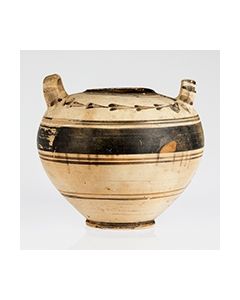 Large decorated Messapian two-handled jar
Large decorated Messapian two-handled jarPerfectly preserved, no damages or restorations. Very rare for such large vessel. From an old British collection, acquired in the 1950s.
Price: on request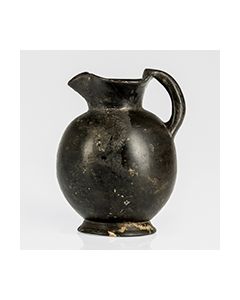 Etruscan bucchero oinochoe found at Tarquinia
Etruscan bucchero oinochoe found at TarquiniaLarge jar with globular body and trefoil mouth. From an old German collection, acquired in the 1950s.
Price: on request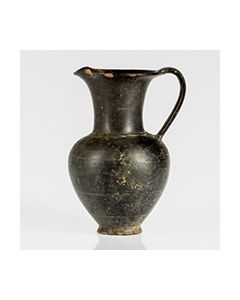 Etruscan bucchero oinochoe from Tarquinia
Etruscan bucchero oinochoe from TarquiniaLarge jar with ovoid body and trefoil mouth. Decorated with carved lines. From an old German collection, acquired in the 1950s.
Price: on request Roman transport amphora found at Sezze
Roman transport amphora found at SezzeNicely preserved, large amphora from the Mediterranean sea. Attractive marine patina. Found in Sezze area (Latium).
Price: on request Very large Campanian red figure skyphos
Very large Campanian red figure skyphosDecorated with figures of youths, framed by palmettes. From an old German Frankonian collection. Acquired in the 1920s - 1930s.
Price: on request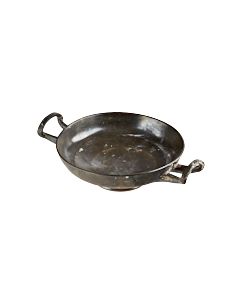 Greek Kylix
Greek KylixDelicate piece of art, from an old German private collection. Acquired 1976 - 1978 in London, probably at Davies Antiques Gallery.
Price: on request Decorated Skyphos found at Alexandria
Decorated Skyphos found at AlexandriaImpressive, massive piece from an old German private collection. Acquired 1976 - 1978 at Davies Antiques Gallery, London.
Price: on request High Daunian presentation plate
High Daunian presentation plateFrom an old German private collection, acquired 1978 at Davies Antiques Gallery, London.
Price: on request High Daunian presentation plate
High Daunian presentation plateFrom an old German private collection, acquired 1978 at Davies Antiques Gallery, London.
Price: on request Italic Quatrefoil Fibula
Italic Quatrefoil FibulaExtremely well preserved double spectacle brooch dating to the early Iron Age in Italy. 8th cent. BC.
Price: on request Egyptian Eye of Horus
Egyptian Eye of HorusSmall amulet in form of the Eye of Horus. Popular type of protective amulet from Ancient Egypt.
Price: on request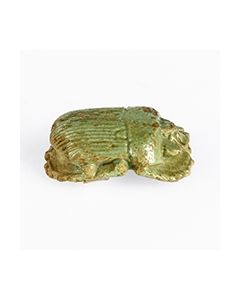 Naturalistic scarab
Naturalistic scarabFunerary scarab in mint green fayence. New Kingdom of Ancient Egypt. The piece is from the famous Matouk collection.
Price: on request Pair of Achaemenid gold bracelets
Pair of Achaemenid gold braceletsFantastic example of the gold jewellery of the first Persian Empire. Late 6th to 5th cent. BC.
Price: on request Corinthian skyphos with harpies or syrens
Corinthian skyphos with harpies or syrensPerfectly preserved vase with frieze showing four harpies or syrens. From an old German private collection, acquired 1978 at Charles Ede Gallery, London. Coming with an ArtLoss certificate
Price: on request Large greek terracotta bust of a woman
Large greek terracotta bust of a womanDelicate work of art, very nicely preserved. From a Munich private collection in which it was acquired around 1976. Coming with an Art Loss certificate.
Price: on request Roman bronze theater mask with eye inlays
Roman bronze theater mask with eye inlaysImpressive massive piece with great dark patina. Coming with an Art Loss certificate.
Price: on request Roman marble figurine of Salus
Roman marble figurine of SalusMarble torso of Salus or Hygeia, the goddess of health, holding a serpent in her arms. From the collection of Dr. Bruno Kirschner, Israel. Exported from Israel with permit of the IAA.
Price: on request Egyptian ushabti for Somtus-tefnacht
Egyptian ushabti for Somtus-tefnachtThe mummiform funerary figurine dates to the Late Period of ancient Egypt, 26th to 31st dynasty. It is remarkable that it probably originates from the burial of two brothers, Somtus-tefnacht and Somtus-tefnacht.
Price: on request Ushabti for Somtus-tefnacht
Ushabti for Somtus-tefnachtThe mummiform funerary figurine dates to the Late Period of ancient Egypt, 26th to 31st dynasty. It is remarkable that it probably originates from the burial of two brothers, Somtus-tefnacht and Somtus-tefnacht.
Price: on request Perfect Marcus Iunius Brutus Denarius
Perfect Marcus Iunius Brutus DenariusExtremely fine attractive piece with beautiful patina.
Price: on request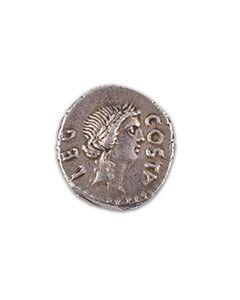 Marcus Iunius Brutus Denarius
Marcus Iunius Brutus DenariusExtremely fine. Attractive, fully centered piece with beautiful patina. Ex NAC Zürich auction.
Price: on request Extremely rare Augustus aureus
Extremely rare Augustus aureusNot in RIC, BMC or Cohen. This coin is published in Calico, Bahrfeldt, Banti/Simonetti. Published as part of the Manuel Vidal Quadras y Ramón collection (Nr. 2942) in 1892. Sold in Etienne Bourgey December 1913 auction in Paris.
Price: on request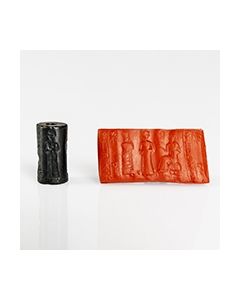 Old Babylonian cylinder seal with cuneiform inscription
Old Babylonian cylinder seal with cuneiform inscriptionWorship scene for a god. Mention of the Babylonian gods of storm, moon and sun in the inscription.
Price: on request Old Babylonian cylinder seal with cuneiform inscription
Old Babylonian cylinder seal with cuneiform inscriptionWorship scene for a god. Mention of moon god Sîn and Aya, wife to the sun god, in the inscription. 1900 to 1600 BC.
Price: on request

